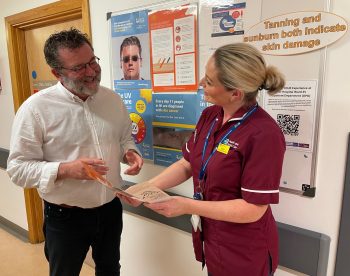
As thousands of people flock to Portrush to enjoy the spectacular Open Golf Championship, a South Eastern Trust Consultant Dermatologist, Dr David Alderdice, is reminding everyone to stay sun safe, even when the weather is not sunny.
With forecasts predicting cloud and rain, many spectators may think sunscreen is unnecessary. However, Dr Alderdice is keen to stress that harmful UV rays can still cause damage, even on overcast days. Up to 80% of UV light can shine through thin clouds, so there can be UV exposure that you are not aware of.
Dr Alderdice explained, “Golf spectators will likely be outdoors for several hours, and without proper protection, the risk of sunburn and long-term skin damage increases significantly. Up to 80% of UV rays can penetrate through cloud cover, so it is just as important to apply sunscreen during dull or breezy weather as it is on sunny days.
“People often underestimate how much UV exposure they get at outdoor events like The Open. You can easily get burnt without realising it, especially if it is cool or cloudy. I would urge everyone attending to protect their skin with sunscreen, wear a hat, sunglasses and where possible, cover up.”
Highlighting the importance of applying sun protection, Dr Alderdice added, “What we are trying to do is prevent Skin Cancer and to pick up melanomas as early as possible. The first 18 years are very important and it is really important to protect children and young adults. SPF Sun Protection Factor 30 or more protects you from UVB, but there is also UVA. It is very important to get a cream that also protects you from UVA as it has a longer ‘wavelength’ and causes deeper penetration, ageing of the skin and can also cause Skin Cancer. You might not notice that you have been exposed to UVA, as it does not cause redness or burning like UVB.
“Everyone should remember that sun cream does not last all day. You should reapply sun cream every two hours, even if it states that it gives you full day protection.”
Being aware of the signs and symptoms of Skin Cancer is important to look out for, Dr Alderdice stressed, “Across Northern Ireland we have a lot of people with fair skin and those with quite a few moles. It is the change in moles that we are encouraging people to be aware of. If a new mole develops, think A, B, C, D. If the mole is ‘A asymmetric’ or ‘B’ if the border becomes jagged or blurred, ‘C’ stands for colour, if the colour changes, if it becomes darker, if there is multiple colours involved, then that is a worry and finally ‘D’ the diameter, if it’s increasing in size, be vigilant.
“We would recommend that you keep an eye on moles regularly and take some photographs. Get somebody at home to take some photographs, approximately 25 or 30 and store them on your phone, it is so easy to do. Each month, check them and see if there are any ABCD changes.”
“Look after your skin, these small steps make a big difference to your skin’s health both now and in the future.”

Dr David Alderdice & Alison Kearney (Dermatology Specialist Nurse)



